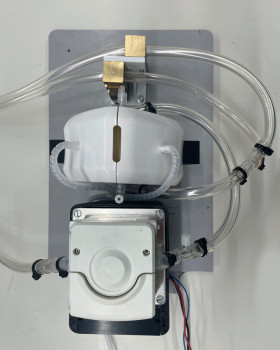Livers intended for transplantation are currently transported between hospitals under refrigeration. The organ can be irreversibly damaged during this process and especially during subsequent warming. An alternative is mechanical perfusion at body temperature, which also supplies oxygen, and the Institute of Rescue Engineering and Emergency Response at Cologne University of Applied Sciences, together with partners from industry and research, has developed a concept device for a new, compact transport system based on this technology.
 Pump and oxygenator in the test standCurrently, removed livers are usually cooled to four degrees Celsius in special boxes with ice for transportation. There is no blood circulation during this phase. Warming the non-perfused organ before transplanting it to the recipient poses a risk to organ function. The developed transport box solves this problem. By means of mechanical perfusion, an organ can be supplied with blood and oxygen at 37 °C outside the body. This also makes it possible to transport the organ over a longer distance and search for the most suitable recipients within a larger radius.
Pump and oxygenator in the test standCurrently, removed livers are usually cooled to four degrees Celsius in special boxes with ice for transportation. There is no blood circulation during this phase. Warming the non-perfused organ before transplanting it to the recipient poses a risk to organ function. The developed transport box solves this problem. By means of mechanical perfusion, an organ can be supplied with blood and oxygen at 37 °C outside the body. This also makes it possible to transport the organ over a longer distance and search for the most suitable recipients within a larger radius.
The concept of a transport box developed in the DeLiver project measures 53 x 69 x 36 cm and weighs around 20 kilograms. It contains a holder for the liver and a peristaltic pump that gently pumps blood or a replacement fluid through the organ under physiological conditions. The temperature in the box can be continuously adjusted between eight and 37 °C so that the removal teams can select the right temperature depending on the condition of the organ. The flow rate is also variable.
As the organ is constantly flowed through during transportation and thus receives oxygen and nutrients, it is possible to significantly reduce organ damage. A syringe pump system also enables the addition of medication, which is necessary to maintain organ function and must be individually adapted for each organ. Thanks to the integrated measurement technology, the system permanently determines the organ's current oxygen consumption. These and other measurement results should enable the transplant teams to assess the condition of the donor liver and adapt their procedure accordingly.
The aim of the project was the proof of concept, which was successful. This enabled the functionality of all components and their interaction with a test stand to be demonstrated. The concept and design would have to be optimized in follow-up projects and clinical tests would have to be carried out before the product is ready for the market.
Source: TH Cologne


